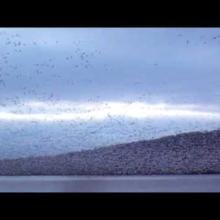

Join BirdNote tomorrow, November 30th!
Illustrator David Sibley and actor H. Jon Benjamin will face off in the bird illustration battle of the century during BirdNote's Year-end Celebration and Auction!
Trumpeter Swans land in a plowed field to forage for remnant potatoes, grain, and other waste crops. This swan is among the largest of all waterfowl; the Tundra Swan is somewhat smaller. These swans migrate in family groups each fall from nesting sites in Canada and Alaska. Learn more about these swans, and view a map to the Skagit Flats of Washington where you can see them. When you go, please be courteous, and if you stop, pull completely off the roadway. Always respect private property. More info at Northwest Swan Conservation Association and The Trumpeter Swan Society!
BirdNote®
Swans Come Calling
Written by Bob Sundstrom
This is BirdNote!
[Trumpeter Swans’ honking, trumpet-like calls]
With deep, unhurried wing-beats, a dozen majestic swans fly in a straight line, their immense, white bodies glistening in the golden sunlight of a November morning. As they fly closer, their long necks fully outstretched, the swans’ syncopated honks reveal their identity: these are Trumpeter Swans.
[Trumpeter Swans trumpeting]
The flock lands in a plowed field to forage for remnant potatoes and other waste crops. With an almost seven-foot wingspan, Trumpeter Swans are among the largest of all waterfowl. At nearly twenty-five pounds, they are among the heaviest of all flying birds.
Now a second formation of swans flies in to forage near the Trumpeters, but these swans announce themselves with a different voice. [Tundra Swans calling] Just a bit smaller than the Trumpeters, their distinctive whoops tell us they are Tundra Swans, a different species. [Tundra Swans calling]
Both species of swans fly south each fall from nesting sites in Canada and Alaska. Trumpeter Swans winter mostly in the Pacific Northwest, while Tundra Swans can be found along both coasts, and at a variety of inland sites in the west. [Tundra Swans calling]
You can see these spectacular birds on their wintering grounds any time between now and the middle of March.
For BirdNote, I'm Mary McCann.
###
Calls of the swans provided by The Macaulay Library of Natural Sounds at the Cornell Lab of Ornithology, Ithaca, New York. The light call and wing beat of Trumpeter Swans recorded by J.M. Hartshorne; the call of Tundra Swans recorded by B.McCaffrey.
Producer: John Kessler
Executive Producer: Chris Peterson
© Seattle Audubon 11/18/05 © 2014 Tune In to Nature.org Revised for 2016 / 2021 November 2023
ID# TRUS-tundra-01b-2021-11-20





